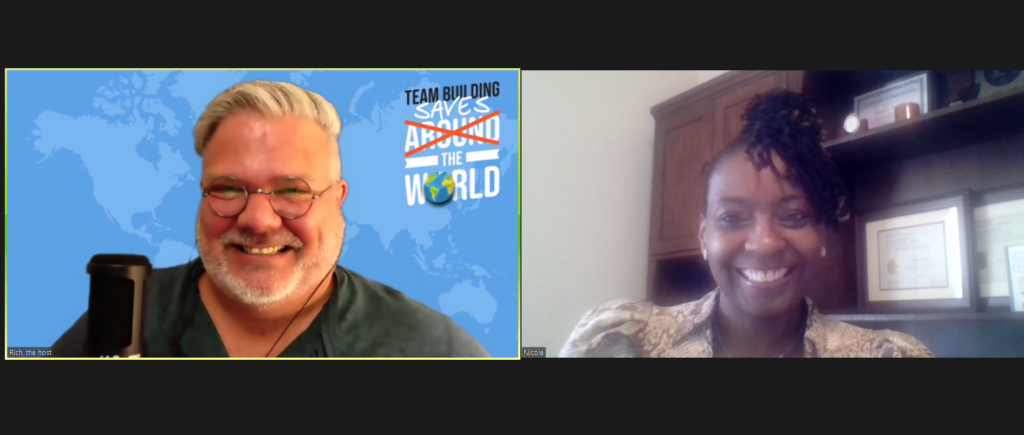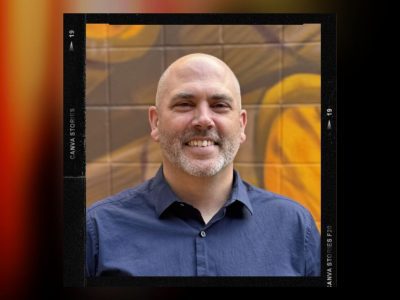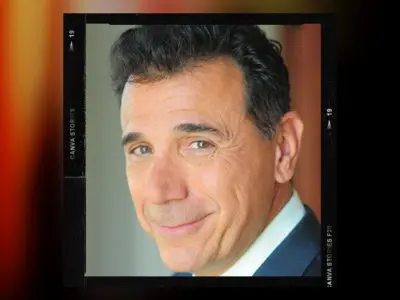Toxic Work Environments
w/Nicole Turner
Use the buttons above to listen now.
Transcript - Toxic Work Environments
Rich: On this episode of team building saves the world. What do you define as corporate culture?
Nicole: One of the reasons why there’s this disconnect is because of what you just said. They’re focusing on the mission.
Rich: We’re not just talking about leadership here though. Are we?
Nicole: No, we’re not.
Rich: How hard are those changes to implement?
Nicole: Some are extremely hard. Maybe it’s because I’m from Mississippi. And I tell people, I give them corn bread in collard greens, you know? Yeah.
Rich: Hello team. It’s me, your old friend, Richard Rininsland host of team building saves the world to show where I speak to the leaders and innovators at the team building industry from all across the globe, trying to find out what about that industry is so important, especially in the world of today. And today we’re taking a deep dive look into corporate culture and toxic work environments with a founder of Nicole L. Turner consulting, Nicole L. Turner.
But first I need to send some thanks out to my supporters, that team bonding. If you’re ready to experience teamwork through the power of play, visit team bonding.com to learn more. And now team joined me in welcoming a consultant and advisor speaker and author who has made a career for herself, helping teams create people-centered workplace cultures and detoxing toxic work environments.
Nicole L. Turner.
and that Nicole is a small group of people. I keep trapped into my desk just so they can applaud you. Thank you so much for coming on board with us today. How are you?
Nicole: I’m wonderful. How are you? And thank you so much for having me
Rich: love it. So let’s start off of course, the way I normally do. Just tell my people a little bit about yourself and how it is that you got started in the, the field of detoxifying corporate culture.
Nicole: Yes. So I’m Nicole L. Turner, the owner CEO of Nicole L. Turner consulting, which is a workplace culture, um, diversity equity and inclusion, leadership development. Um,firm in the Washington DC area, how did I get started? So my career is extremely diverse. I’ve been a teacher, professor, cyber security, professional, national security, professional, and organizational health organizational culture person.
But what I found and no matter what discipline, what, no matter what industry, there was a common thread that. A lot of emphasis was placed on the technical side of work and not so much on the people side of work. And the more I took a deeper dive into organizational behavior and studying human behavior and organizational behavior, I was like, there’s a huge disconnect here.
How leadership sees the organization versus how the people who are the boots on the ground. See the organization is totally different in so many ways. So I just decided that. You know, to fill in gaps where there were some deficiencies as it related to the people side of business, right. I am totally on board with the expression that you take care of.
The people, the people will take care of the mission. And so the hearts of every organization are the people in the organization, you know, as someone who also coaches, individuals, what I found is that when people were dealing with. Issues in their personal life. It showed up and manifested itself in the work environment, either as toxic employees and toxic leaders, which created toxic workplace culture.
Like you can’t like peel off these layers when you walk into the door or log onto a screen, you know, now that we’re virtual and become this absolutely different person, right. Because you’re working. And so I wanted to find. A remedy for what? In some ways it’s kind of like a disease within the organization.
And so that’s, that’s how I got started taking a deeper dive into individual behavior and organizational behavior and how the two intersect
Rich: let’s go a little more simply just in case. I, I always tried to aim this more for people like myself. I’m looking to find the answers for people who may not know anything about the kind of topics that we’re talking about.
Understood. So what do you define as corporate culture first off?
Nicole: So workplace culture, corporate culture is really the behaviors, beliefs within an organization. How that organization goes about its day. I kind of say culture is cause I talk about culture and climates interchangeably. So culture is like, The mood of the organization and climate is like the personality of the organization.
If that makes sense. Cause we all know what mood is and we all know what personality is. Right? So, so if the culture is mood is one that’s grumpy or something. Sad or upbeat, happy that has an impact on everything that it touches from its customer engagement to its board of directors, to, you know, how the productivity.
So when I talk about workplace culture, I just think of it as the mood of the organization, how the organization behaves.
Rich: Now you talked about how there’s a, you seen a huge disparity between what leadership sees as their corporate culture and what the individuals who work for them. See. What kind of differences have you witnessed?
Nicole: So in some instances, you know, leadership thinks that everything is, is great. All my employees are happy. Like I can think about one of my pro public sector, government clients. They were looking at every year, the government does like a federal employee before I serve it. And so this particular organization, their survey results were pretty bad.
Right. But the leadership was like, oh, it’s because we had secret station. The government was shut down. People don’t really feel this way, but the truth of the matter is people really did feel that way. It had absolute, if you, I went back and looked at previous year’s data and it was the same, whether that was a shutdown or not.
And so it’s like, they’re blinders. Sometimes at the higher level within the organization. And of course this is not absolute. This is not everybody who thinks that way, but the difference is they usually think the organization are, or the company is doing better from an employee perspective than what employees truly feel.
Rich: What is it that causes that disparity, do you think? Is it, I mean, I assume everybody in a corporate culture is more goals focused, more, more oriented towards, uh, uh, bottom line or the, the, you know, the end of the fiscal year. Is it because their numbers were still good in that regard that they figured everything else must be fine behind it.
Or
Nicole: I would say whether it’s public or private when I’ve known, um, and what I’ve observed and dealing with with my clients is that one of the reasons why there’s this disconnect is because of what you just said were focusing on the mission and what happens oftentimes in an organization is that. They promote people who are really great at the technical as they should, they paid their dues.
Right. But a lot of organizations don’t have a leadership development program to prepare them to lead people. Right. And when you still need some massaging and some growth from the interpersonal perspective, That’s where the disconnect tends to come. Like they’re really great at cracking the whip. And I tell people the big difference between managers and leaders is that managers focuses on the task and leaders are those people who empower, inspire, motivate.
They make you want to follow them. And we’ve seen the little means that have the leaders and the front right. And the people are following. Whereas the managers, the people are in the front and the managers are in the back, you know, like cracking the whip and forcing the task as opposed to motivating the employees to want to do a good job.
So part of the issue is they’re not prepared from a leadership development, interpersonal skills perspective to even see all they’re looking at the bottom line. Okay. We’re getting out these many widgets. So who cares if my employees feel like they’re, they’re burnt out and they’re overworked and they’re miserable, we’re getting out of these many widgets.
Rich: Plus how many of them must think that my. Corporation, you know, while they have those technical experts that the corporation is made up of more than just them, you know, there’s still the customer service reps. There’s the,
Nicole: they’re still the marketing, they’re still the communication. They’re still the human human resources.
You know, there there’s so many other elements that, and I think a lot of places see those as a. The, the fuzzy areas. They don’t really impact business. You know, they don’t really impact dollars, but the truth of the matter is they do impact business than they do impact dollars. And what people fail to realize is nowadays everybody researches a company.
If I’m considering. Hiring your company to come do work for me or for my states or for my government or whatever business, a business I’m going to research it. I’m going to find out what your employees are saying about you. I’m going to find out what your reputation is in the community, in your industry.
And if they’re a public traded company, you can go to the securities and exchange commission, a site called Edgar, and you can see how many times they’d been sued. And if they were sued by employees and what were the outcomes. So people fail to realize that. In a business it’s also a part of your brand and how you treat your employees is a major impact on that brand.
Rich: What are some of the negative implications for a company?
Nicole: The a negative implications is. Business the bottom line dollars, you know, so if I’m looking at you as a company that I want to bring in and do business with, and I see that you have a bad reputation of how you treat your people, I’m going to want to go to the next person or the communities in which your business operates.
You don’t do anything to support the community and the people within that community. You don’t hire people from the community. When I look at your website, It doesn’t show diversity. You know, there’s so many things that go into play. When someone is looking at either working for you or hiring your company, doing business with your company, it’s no longer the yes, because I’m popular and I’ve been around forever.
People are looking at a variety of things now that go into play. And the bottom line is if you’re not. Being more aware of the difference in the workplaces now. And I’m not just speaking from a diversity equity and inclusion, but just how the country is shifting. We have five generations now and they say in the workplace and the things that I’m a gen X-er.
So the things that I may see as a gen X-er the gen Z’s and Y’s wants something different and you have to be able to pivot. Right. And if you’re unable to pivot and unable to see the changes that are on the horizon and are kind of like stuck, and this is the way we’ve always done things. At some point, the competition is just going to wipe you away.
They’re going to offer to buy you out, or you’re going to see less business coming in less revenue, higher turnover from the employee perspective. Retention is going to be an issue. Morale is going to be an issue. Engagement is going to be an issue. Productivity is that’ll be an issue.
Rich: So listening to that feedback that you were discussing before that they’re just discounting, it seems pretty simple, right?
Nicole: Yes. That’s very important. So how do you, I’m sorry, go ahead.
Rich: How do you get a leader to listen when they haven’t been they’ve? I mean, they’ve made a career for themselves while not having to.
Nicole: Right. And so one of the things that I do when I have more advisory coaching executive coaching sessions with those leaders is that I tend to find out more about the individual because in studying organizational behavior and culture, what I find is if you can get to the more personal side of them and relate it to something personal in their, in their lives.
Like one particular leader, you know, I, I brought up like relationships. So imagine if this was a relationship and your spouse is telling you, or you’re telling your spouse, all the things that he or she is doing wrong. And they’re like, oh no, you’re just making it up. That’s not real. You feel discounted, you feel invalidated or whatever.
It’s the same way in the work environment. So I find. Things that they can connect to on a more personal perspective, which begins to shift in their mind to like, okay, then perhaps that is what’s going on with my employees. And it’s not always easy because a lot of times there’s the accountability piece, right.
If I. Say I agree that this is an issue, then now I’m accountable for making change happen. And sometimes they’re like, and then I have to, for them, it’s an admission that part of the problem. Right. And that’s hard for some people to do.
Rich: How do you get them beyond that point?
Nicole: When it’s, uh, I’m not seeing myself as a problem or I’m not going to have an accountability perspective.
What I tend to do is tell them what the risks are. If they don’t what’s the long range outcome, if they don’t. And so when I put it in. Terminology that they can relate to, you know, whatever their industry is, but it in terminology that they can relate to and show them like, this is what happens over the next one year, three years, five years, if you don’t do X, Y, and Z.
Rich: Can you
give me some broad examples? You don’t have to go into specifics about any particular client,
Nicole: like, so for one of my clients, they are a gaming company, right. And as we know, gaming business is like just booming, but they’re kind of a startup. And so. You know, they were in the beginning having some little people issues, culture issues.
And I was like, let’s get ahead of this now because you guys are still kind of in the startup phase. Right. But the owner was like, no, this is my, you know, no, I don’t, we don’t have these real issues. And so what I did, I showed them examples of what competition was doing. And then I brought in like, market value.
Like, this is where, where you are financially. This is what will happen to you. If you don’t address these issues, like, yeah, you’re, you’re good now, but I promise you, when you look at your competition and you look at your standing in right now at this level in your company, you’re not going to make it two years from now, if you don’t address, because people are like, why would I do business with you?
Why as a customer. Why would I buy your product when you just don’t care about your people and the more your reputation gets out there, the more it impacts you. So I had to bring it in from a perspective, here are some of your competitors, which required me to do deeper dive into competition. Right? And then I had to create a spreadsheet like dollars put it in for them.
Rich: What are the kinds of risks will they be facing? If they’re not able to make these changes?
Nicole: So if they’re not able to make these changes. So let me talk about the numbers from a disengagement. When your employees are disengaged, it costs $450 billion a year. Galup absolute love them. They do, they do all kinds of research and studies and they did a study in 2018 that said the cost of disengagement is 450 billion a year.
So if you’re not addressing the issues, think about all the times that you have turnover. And the cost for every new employee that you have to bring in, bring it up to speed, get training, onboarding on average for every new employee. Just to get that process done is on average about $12,470. In addition to what you’re paying for there.
Salary, just the cost of bringing them up to speed, the cost of replacing, hiring, going through all of that. So let’s say if you had 10 employees leave in a six month period of time and multiply that by 12,470, look at how much you’ve wasted, how much you have lost, you know, and then just the fact that. If they are an expert in their field for what you hired them for when they walked out the door, that knowledge walks out the
door with it.
Rich: Yeah. And they’re going to the competition too.
Nicole: Yeah. Yeah. Probably went to the competition. Yes.
Rich: With this disengagement do you consider that just people quitting. Are there other forms of disengagement?
Nicole: Disengagement? I sometimes we’re, even though, regardless of the age of a person, I sometimes say it’s like retirement in place.
I’m here, but I’m not being productive. I’m sitting at my desk or I’m sitting at my laptop, but I’m not being productive. I’m, I’m spending time doing other things
Rich: back into this and just a quick second, but if you don’t mind, I need to take a second here and actually send some love out to my supporters.
Okay. Out there about a company, I am very proud to work for team bonding. Team bonding was founded over 20 years ago. With one simple question. How can employees have a great time while fostering strong, authentic bonds between people who work together? They’ve created a catalog of innovative events using the power of play as a learning tool and tapping into the correlation of work and play from scavenger hunts to jeopardy and so much more.
The team bonding of activities live virtual and hybrid maximizes the impact of team building with an accent on fun. Visit team bonding.com to schedule your event now, team bonding when you want seriously fun results. And we’re back with Nicole, Nicole. This is all fascinating. We’re not just talking about leadership here though. Are we?
Nicole: No, we’re not employees play a role in, in toxic workplace. Those employees who we, for the people who have worked in a corporate environment, you know, those coworkers, as soon as you get in, they meet you at the coffee pot or in the little kitchenette or the break room. And they want to start with the office gossip, or they sit across from you.
If you’re in cubicles and you see that they’re not pulling. Their weights, but they’re getting the same performance appraisal as you are the same perks as you, but they’re not doing the work right. And all they do, they may be those employees that, you know, all they do is complain. Spread gossip are lacking in productivity.
Or just disgruntled, the main girls are mean guys at work, you know, so, no, it’s not just leadership. It’s also those people who are not in leadership positions.
Rich: Well, what kinds of things do you see or have you seen, or individuals in a corporation?
Nicole: So one of the biggest things that I have seen is the gossiping and the spreading of rumors.
And the lack of productivity is, is what I’ve seen. And it’s funny, like in those environments where those things are very prevalent and, oh, I’ve also seen bullying up and people don’t talk about that in the workplace bullying up, they think about bullies. It’s usually they think about the manager bullying the employees, but I’ve also seen employees, bullying managers.
And yeah, because sometimes the managers are just very nice people and, you know, they care about him, the employees, they care about the work and employees see that as a weakness and they see that as, oh, this is a way for me to get what I want because he or she’s not going to get pushback. You know, they’re not going to want to put me on a PIP, a performance improvement plan.
So. You know, let me just bully them. And then it becomes an intimidation thing. And we often think intimidation is top down. We don’t really think about it as being
Rich: awesome. I mean, not that that’s awesome, but even, even thinking about it, but yeah, let’s, let’s talk about that bullying some more. Do you have any other examples on it and, and how do we fix it once we’ve seen it?
Nicole: Yeah. I mean, from bullying, it’s also employees bullying their peers. Yeah. Yeah. And so when bullying shows up in the workplace, one of the things that has to happen is that you have to have meetings, have conversations with the employee that’s. Doing the action. Okay. And if you not getting remedy from what I considered to be a counseling session, to bring it to their attention, because there is, we know there’s always three sides to every story his hers and the truth.
Right. And the truth is usually somewhere in the middle. And so, you know, it’s important to hear. Both sides of the story. If there are some people who were witnesses to it, you know, that’s good too, but I always start with a counseling session just to like, I won’t even call the initial conversation at counseling session just to get to the root cause of what’s really going on because sometimes it’s a perception, the way some people may just be strong personalities and the way they talk or their mannerisms may come across and be misinterpreted as being a bullied.
But that’s really not who they are. And a good example is that I can remember. When years ago, when I taught middle school, I had a principal who I thought was not only a bully, but just very mean, but then I found out. Years later that she was in an abusive marriage and the only place where she had power was in the workplace.
So again, that goes to finding out more about the individual, because a lot of employees who show up as bullies in the workplace, there’s always something usually external that may have started in their childhood, their early adult life, or going on currently in their lives that lead to that behavior.
You know, and so it’s important for managers to one, have a conversation with the employees and if the next step, if it doesn’t get, you know, um, rectified or any remedy, then you have to write them up for conduct issues. And some of those conduct issues, if they’re ongoing comes with whether that’s a suspension or.
You know, time off without pay and then eventually termination, but there is a process unless it’s like, you have to address it. Now there’s no remedy to just like put it in phases. This person is doing some outrageous things they have to go. But if that’s not the case, you know, that’s how you start to address the behavior.
And if their behavior doesn’t change, then there is no other option except terminate.
Rich: Sure. Plus how many bullies actually see themselves as bullies?
Nicole: Most don’t right. You know, to them, this is, this is just me. I’m not, I’m not being a bully, but what’s funny about not funny. Ha ha funny but funny about this behavior, sometimes I find in the workplace is there, they’re just modeling the people who they want to be like, like in the workplace, if you had a boss or you had a person in the workplace who was a mentor of yours and you saw that.
They displayed this behavior and they kept moving up the ranks. Right? So you’re, you’re sending the message that this is how you act in order to move up. The person may not even be aware that the behavior, because they are so close to that person from a mentoring perspective, or they admire that boss, or they admire that peer.
And so to them, this is what you do to be a leader, right? No, it’s not what you do.
Rich: All right. So we’ve identified some of the problems. You have been brought in to, let’s say I’m, I’m a leader you’ve been brought into my company to help alleviate some of the, some of the toxicity. What are some of the recommendations you give? Uh, what is with the changes that I need to make?
Nicole: Well, even before I can get to the recommendations, if I can’t just go by what the person who brought me in to saying, so what I always recommend coming in is let me do an assessment with your employees. Let me do what I call an organizational climate assessment, organizational culture assessment.
Let me do some one-on-ones and focus groups so I can get to the root cause of what’s really going on. Right. I can’t just make a recommendation. I tell them it’s like going to a doctor, you know, you have all these complaints. But the doctor also has to do some tests before he, or she can, you know, ruminate the diagnosis and then prescribe a solution.
Right. And I worked the exact same way I have to go in and identify what’s really going on. And I can’t just take your word for that. I have to get data collect data that tells me that validates what you’re saying or refutes what you’re saying. And then from there I make the recommendations and sometimes some of the recommendations are, yes, we need to do some leading with emotional intelligence classes.
Some of the recommendations are you have some communications issues. You have some trust issues, bring in people who can do classes on trust or help you do better with trust in the workplace. As far as our communications, I tell them the rumor mills should never tell your employees something before you do.
So let’s focus on this. Top-down. Circular bottom up communication. So I just at first identify where their pain points are. And then I make recommendations based on that.
Rich: How do you get individuals in a corporate environment to trust you? Enough to be honest with you.
Nicole: You know, the funny thing is because they’re, once they’re no longer with their peers or their boss and it’s just me and them or somebody on my, in my company, somebody on my team, I really talked to them.
I tell them I was like, we’re just, we’re just like friends hanging out, having a conversation. And. Maybe it’s because I’m from Mississippi. And I tell people, I give them corn bread and collard greens, you know, sometimes, you know, they feel more comfortable. One because I am an outsider, right. I don’t really have a dog in the fight.
I’m not going to disclose any specific information that makes you identifiable. I’m just collecting things so I can identify what the themes are throughout the organization. And so once they know that they’re going to be. They’re not going to, there’s not going to be a disclosure of who they are, any specific information to identify them that makes them more comfortable.
And then, you know, just, I try to create an environment where I don’t want you to feel like this is, you know, a tense conversation. I want you to feel like you’re just, what would you tell your best friend about the work environment? Right. And that’s pretty much how I go into the conversations and believe it or not, initially people start out with, oh, it’s just great.
And, oh, this, but there’s this one question I ask after I go through my series of questions. Is there anything you want to tell me that I did not ask you? And it has not failed me. I do like so much stuff because now they’ve been talking to me for like 30 or 40 minutes, they feel comfortable. And then they’re like, okay, well let me just spill it now.
Rich: I was always brought up on the idea of my father was very much a part of the corporate machine and he was always like, when you go out for the job, you do not complain. Right because the squeaky wheel doesn’t get grease. The squeaky wheel gets pushed aside and then left. This is of course coming from a man who grew up in the fifties, you know?
And,
Nicole: but some of that is still true today. Right. So when I’m talking to the employees individually, because I never talked to them in, and this is a focus group and they choose to be in a group together. Like if they work on the same team and they’ve already been venting to one another, um, I think the fact that they know.
That their leadership is not going to know them. Um, the ramifications, uh, retaliation, you know, it’s not as much of an issue because they know they’re, I’m not gonna disclose anything that would identify them.
Rich: Okay. Now let’s look at the other side of it. So I’m the manager, CEO, CFO, whatever I might happen to be for this corporation, I’m bringing you in uh, because it was recommended that I do so, but especially as a manager, I’m thinking there’s no way, you know, more about my people in my team and my company than I do. How do you get my trust?
Nicole: Well, first of all, I tell them that I’m here to support them. I want their company to be, or their organization to be successful.
So I’m here as your trusted advisor, I’m here as your support because you have goals. And I, one of the first things I talked to them about are their core values. Like what’s your organization or your company’s core values. And if they don’t have it, then that’s a whole nother conversation. And then I align what I’m trying to do to them do for them and how that their core values play a role in it.
Like, you know, if you have a value to some of the people that I’ve worked with recently, one of their core values is how they show up in the community and giving more back to the communities in which their company. Resides. Right. So I talked to him about how the things that are going on internally with their employees have a direct impact on, on the community.
That’s just one example. And so I start there, like, what are your values as for a company? What are your values as an individual? What are your values? Because sometimes they are not the same, you know, and. So that’s how I try to build trust with and let them know I’m here to help you. I’m here as your trusted advisor, you know, I want to make sure you’re as successful.
I want to help this company be the top in your industry.
Rich: Okay. So you’ve gone through your interviews. You’ve, you’ve gone through your data. You have a list of changes that you think would be beneficial. How hard are those changes to implement?
Nicole: Some are extremely hard and extremely hard because one, it may be a resource issue.
It may be a money issue. It may be a time constraint issue depending on the industry. And two it’s, it could be an issue because, you know, it requires them to think differently. And as we know in our own personal lives, change is hard thinking differently when you’ve been thinking a certain way for a long time, it’s hard something.
So when I give them recommendations, I give them as quick wins. Like here are the things that you can do immediately that will start to shift things. And then I give them a short term wins long-term goals, right? Like you can do this over the next year and you can do this over the next three years over the next five years.
So I break it down into pieces that are digestible. And usually once they see, oh, there’s something I can do easily, like a quick win, like communicate with my employees. Maybe I should have meetings once a month with my team, as opposed to once a year, you know what I’m saying? Or I should send out. Teen create a newsletter to let people know what we’re doing.
Those things are quick wins. So once they start to see the impact of the quick wins. Cause as we know, we’re putting forth effort in anything personal professional. Once we start to see positive change, we want to keep that momentum going. So I break it to them and digestible pieces over like quick wins short-term long-term.
And a lot of times they, some of them do ask me to help them through implementation because it is so new to them or to advise them through implementation. And, and I’m like, of course, you know, I want you to succeed.
Rich: So looking at an individual. Who for some reason is not living up to the potential I, as a manager might want them to be, how is creating a better environment for that one individual, especially as you said, there are so many different types of people in the marketplace now.
Right. How can, how do I actually answer to everyone? How do I make it better for everyone and still consider that one person?
Nicole: So it’s really difficult to just make it better for one person. And so what I do when I present my findings, one of the things I do is present it as themes, right? And those things that show up for that one individual probably show up for more than likely show up for other people.
So. Yeah, you want to help that individual grow. And if you know, if they’re a direct reports to you, you, you tend to have like some companies they may only have, depending on what your rank is within the organization, they may only have 10 direct reports or only have five direct reports. It’s a lot easier to give more specialized attention if you have smaller teams.
Now, of course, if you are. Because usually the CEO of the company, the CFO, the CIO, they have a small group of people who are their direct reports. And then those people have their own direct reports, you know, for the, unless you’re a matrix environment, that’s a little different. And so it’s a little easier if you have a smaller group of people who report to you to give more specialized attention.
And I also to address that that person may not be the best fit for the job you initially hired them for, but there may be other. Departments in your organization that they’re absolutely rock stars. And so I try to convince managers and leaders that don’t just write them off. You can benefit, it could be a win-win for you and you know, for you and them just move them to a place that’s a better fit for their natural skills and skills and ability.
Rich: What kind of examples of toxicity have you seen from any company? Yeah. Yeah. Within the corporate environment.
Nicole: So I’ve seen unfairness as it relates to policies. Like you have policies and rules in place, but depending on if the manager or leader likes your personality or not like your personality, things are not fair and equitable across the board.
I’ve seen narcissistic leadership where it’s all about me, me, me, if something goes wrong, I’m going to blame you as a leader. I’m not going to take ownership. If something goes right, I’m going to take the credit. You know, I I’ve seen narcissistic leadership. I’ve seen unfair policies and practices across the board.
I’ve seen transparency and communication issues. I’ve seen where morale is super low. There’s a lack of work-life balance. You know, I’ve seen areas that may have lost a significant number of people, but then you expect the small group of people there to still operate as if they’re fully staffed and at least to burnout, which leads to stress.
And the high number of people, you know, who have stress in the workplace and how that impacts their, their health, their mental, physical, and emotional health. I’ve seen that, um, EAP services are on the rise. Employee assistance programs are on the rise because many more employees are suffering from burnout, suffering, from stress, having suicidal thoughts in the workplace and all these things that we wouldn’t not have normally expected to happen.
are now. Happening even more, more so than, than ever. And now with COVID people are home, more people are stressed, more people can’t have that connection with family and friends. People have lost loved ones. And when you have leadership that. Does not have empathy does not show compassion does not show emotional intelligence.
Right. That also shows up as toxicity from a leadership perspective. Like I, you know, for an example, let’s say someone says, I just, I just lost my brother to COVID and the manager’s like, I don’t care. You know, we have a deadline. You know, you take one day, but I need you to be back on or you’re on bereavement leave or you’re on leave and they’re constantly sending you emails or maybe call your phone, you know, they, they want to know everything.
Yeah. Right.
Rich: Yeah. Especially something like narcissistic personalities, especially in a leadership role. Um, I mean, how do you. What can, what kind of recommendations would you make against that or to help bolster against that?
Nicole: When there’s a narcissistic leader, sometimes I have to have a conversation with their boss.
Now, the challenge is if they are the overall boss of the company, Right. That that becomes a little more challenging, but if there’s somebody that they report to, but I initially try to work with the individual because a lot of times people really don’t see themselves the way other people see them. And when you have to put a mirror up to their face, it’s, it’s very hard.
And, and sometimes for them it’s embarrassing sometimes for them, it. It questions, you know, they’re standing in their industry as far as from a leader, senior leader or executive perspective in their minds, that to the external world. And so one of the first things I do is highlight certain behaviors.
That, that I’m hearing that they are displaying. And then I give them, provide them examples of, if you just make one or two little changes, how that impacts, you know, their, their division, their company, their directory, their branch, whatever level in the organization unit that, that it is. Right. But it’s, it’s hard.
It’s very challenging. It’s sometimes that the recommendation is that they get a coach. Like I’m recommending you get an executive coach because I’m seeing X, Y, and Z, right. Or I’m recommending that you get a, an advisor because I’m seeing a, B and C. If you don’t, these are, you know, what can happen had happened for you in your career?
You know, at some point you may have find yourself looking for a new job, because they’re about to push you out the bottom line productivity profits. You know, it depends on the individual. Like I tell my clients, I don’t have a one size fit all because everybody is different. Right. And so how I address it really depends on the individual, the company, the situation, because everybody’s different
Rich: from your point of view, now that we’ve seen more people being vaccinated, the, the country is starting to loosen up restrictions.
Is it better to have people back together in an office and a communal space? Or are we still at that point where we should be doing remote?
Nicole: I think we’re still at that point where we should be doing remotes. Uh, if you bring people in, I definitely don’t think. We should. I know that there are some industries, people have to be in the office.
They have to be in the workplace. They have to be, you know, wherever. But what COVID has shown us is that you don’t have to have people together all the time to get the work done. But what research has also shown is that people are more devoted to an organization and are happier at work. If they have a best friend at work.
Right. And so that socialization in the workplace is part of the employee wellbeing, like being able to socialize with my peers and my colleagues. So I think there has to be moving forward because the workplace is forever change. Moving forward. There has to be a balance of in-person versus virtual.
Right. And every company has to do what’s best for them, of course, but I don’t think. There should ever be anything that says people 100% has to return, but give people the option. If they want to come to work one day a week, two days a week or four or five days a week, give them the option, but don’t make it mandatory.
But I do think people need that socialization. And when they feel more connected to someone in the work environment, they tend to sometimes feel more connected to the work itself.
Rich: Last question, nicole, if I am an employee who finds themselves everyday dreading coming to work, that the toxicity levels are, are insufferable. What can I do?
Nicole: So yeah, people do suffer from that. They may get stomach aches, headaches the Monday, this Monday, blues dreading Mondays. So I tell them first, you know, your mental and emotional health is essential. So if there’s something that you can go to your boss and say, Hey, I’m having issues with this.
And you don’t feel like there’s going to be retaliation or reprocussions from that. Maybe there are some changes that can be made, because like I said, in the very beginning, there’s tends to be a disconnect between what. Managers leaders think is going on and what employee. So they may think you’re perfectly fine.
Give them the opportunity to meet you in the middle if they can make change happen. So I, the first thing I say, talk to your boss, if you’re having serious issues, right. And if you get no solution there, I tell them the next step is start working your exit plan. Don’t just quit a job, right? If you could, you don’t have a job to go to and you don’t have enough savings to sustain yourself, but I would really start working my exit plan.
And I tell them in working that exit plan, identify what you like well about this job and what you don’t like well about what you don’t like about this job. And then moving forward, never look for a job out of desperation. Because we’ve all heard the expression. You don’t want to jump out of the skillet into the fire.
And when you’re trying to make change happen rapidly out of desperation, survival mode, you tend to not go to something that’s even better. It’s different, but not better. So I always recommend start talking, talk to your boss first. If that doesn’t work, start working your exit plan. And sometimes our exit plan may take six months to a year, but start working it so you can get to an environment that’s better for you mentally and emotionally.
Rich: Fantastic. Nicole, thank you so very much. I loved this conversation. Um, I have been, I’ve been told by my higher ups that I kind of need to make these interviews a little bit shorter, but I could talk to you about this on it’s not only fascinating for me, but it’s so important. Especially now today, but definitely we do need to move on because I want to see how you’re going to do on my speed round.
there’s no end of the schmaltz. I will go to, to make the show fun. All right. So Nicole, the way this works, I’m going to ask you a series of questions within 60 seconds. Your objective is to try to give me as concise an answer as you can so that we can actually see how many questions you can get through in 60.
You will know the 60 has begun because the music will start and I will ask my first question, are you ready?
Nicole: Alrighty.
Rich: Fantastic. Here we go. All right. What’s your name?
Nicole: Nicole Turner.
Rich: How many children do you have?
Nicole: I’m sorry, say it again.
Rich: How many children do you have?
How many pets?
What kind of pet is it? Lovely?
All right. Which celebrity chef would you most like to fix you? A meal?
Nicole: Oh, I don’t know. I can’t think of one.
Rich: Okay. What’s the best piece of advice you have ever received
Nicole: your authentic life show up as your true self.
Rich: Nice. Would you rather be the most popular kid in school or the smartest?
Nicole: Smartest.
Rich: What’s your favorite thing to do on a rainy day?
Nicole: Oh, my favorite thing to do is snuggle up and read a book.
Rich: Nice. What’s your favorite vacation spot?
Nicole: I’m not a big vacation person. My favorite vacation spot is to go home to Mississippi and see my mama.
Rich: Excellent. All right, there we go. That’s it. Nicole, you have gotten nine. Nine correct answers. There’s no answers. It’s just whatever you gave me, but nine 60 seconds. So well done. Hey team, let’s give some love out there for Nicole L. Turner. Nicole. Thank you so very much. Once again, for coming on board, is there anywhere my team can go to, to find you and find out more information about,
Nicole: yes. My website is Nicole L turner.com. You can find me on Twitter at the culture pro you can find me on Instagram at the culture pro, and if you’re on LinkedIn, Nicole L. Turner MBA.
Rich: Thank you so very much, Nicole, this was a fascinating conversation. I’d love to have you back sometime in the future and talk more when we see, when we see where business is going, as we start opening up again.
But as for me, my friends, that’s it. We put to bed one more episode of team building, saves the world. Thanks so much to all my team out there for coming on board and listening. If you’re brand new to this podcast, please feel free to tell all your friends, tell your coworkers, tell your boss how much you’ve enjoyed listening and how important this episode might be for you.
But for everybody else out there for everyone out there, please feel free. Like us subscribe, do all the things you can find us in all the different podcasts, places, Google podcast, apple podcast, Spotify, wherever you find your favorite podcasts. We are all over social media. You can find us on team bond, podcasts.
Down Instagram, Twitter, Facebook, wherever you like, you’ll head there. And you can actually leave us comments about what you’ve liked about the show, or maybe what you don’t like about the show. And if I like your comment, I might even read it aloud in a future episode, but that’s going to be at my friends one more time for me to all of you out there.
Thank you so much for coming on board and always remember if you’re within the sound of my voice. You’re now on my team and I’m always going to be on yours. Good luck everybody. And we’ll see you next time.
It’s been said that you learn more about a person in an hour of play than in a year of conversation. So why not put your coworkers to play with the help of the team? Team bonding team bonding was founded over 20 years ago. With one simple question. How can employees have a great time while fostering strong, authentic bonds between people who work together?
Their catalog of innovative events include scavenger hunt, jeopardy, and much more each activity whether live virtual or hybrid maximizes the impact of team-building with an accent on fun. Visit team bonding.com to schedule your event now, team bonding. When you want seriously fun
result.
June 15, 2021
Even if you think things are good, it’s best to check in with your team.
With concerns about toxic work environments on the rise, Rich talks to Nicole L. Turner about the process of creating a people-centered and detoxified workplace.
As CEO of Nicole L. Turner Consulting, Nicole has transformed many organizations. Her clients have seen a higher level of productivity, employee engagement, morale, inclusiveness and belonging, customer satisfaction, and an increase in profits.
Nicole is known as The Culture Pro™ because she is able to transform organizations by assessing the culture, diagnosing problems, and implementing a variety of interventions designed to drive tangible actions. Nicole L. Turner holds graduate degrees in Education and Business, has a graduate certificate in Diversity Studies, and is a certified Human Capital Strategist, Strategic HR Business Partner, and a Prosci-certified Change Manager, and an Executive Coach. Nicole is also a Diversity Value Index Judge. As a judge, Nicole uses defined metrics and benchmarks to assess how organizations are implementing Diversity and Inclusion programs and leveraging those programs to create business impact.
" The big difference between managers and leaders is that managers focus on the task and leaders are those people who empower, inspire, and motivate."- Nicole Turner

Get more human resources and leadership advice.
Less drama? Greater teamwork and job satisfaction? TeamBonding is here to help you build a stronger and happier team. Subscribe to get our team building podcast and thought leadership blogs sent straight to your inbox.













